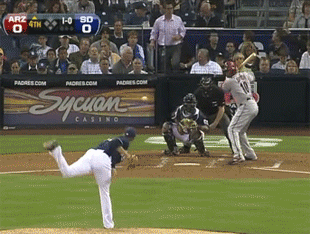Pop quiz: Which of these three home runs hit by Justin Upton over the last three years had the longest true distance?
A) July 27, 2011, at Petco Park vs. Cory Luebke
(Although MLB video says that this video is embeddable, it does not actually show when embedded. Click here for the full home run. Meanwhile, this gif focuses on the good stuff.)

B) June 20, 2012, at Chase Field vs. Jason Vargas
C) April 1, 2013, at Turner Field vs. Cole Hamels
Let's watch them carefully. In the first video (gif), at Petco Park in 2011, Upton's blast lands far beyond the left-center field wall, bouncing at the deepest end of the San Diego bullpen and into the special row of shrubbers' seats above. Upton seems to know that the ball is out, quickly but emphatically dropping his bat and setting off into a sprint of a home run trot.
In the second video, at Upton's previous home Chase Field, the ball lands high above the left-center field wall in the party section that sits above and at an angle to the left field bleachers. At the plate, Upton enjoys his handiwork, taking two or three slow steps out of the box to watch the ball fly before tossing his bat to the side and beginning his trot.
In the third video, on Opening Day this year in Atlanta, Upton sends the ball deep into the left-center field bleachers, with it coming to rest about halfway up the section. Either because it's Opening Day or because he isn't as familiar with Turner Field as he was with Chase, Upton doesn't seem to realize that the ball is a home run off his bat. Instead, he immediately starts to leg out the double he expects it to be. Of the three home runs shown here, the Opening Day blast has the quickest tater trot.
Now that we've watched the videos, let me repeat the question: Which of these three home runs hit by Justin Upton over the last three years had the longest true distance?
Before I answer the question, allow me a quick aside (this will help people avoid SPOILERS before making their own decision). Monday was the 39th anniversary of Hank Aaron passing Babe Ruth to earn the home run crown. People forget that, before Aaron finally passed Ruth in the first weeks of the 1974 season, the irrepressible Snoopy actually challenged the Great Bambino first. It is one of the best series of strips in Peanuts history, giving us a glimpse into the racism that Aaron faced in his own chase.
With that aside out of the way, it is the third and final video that features the longest home run. The shot off of Cole Hamels had a true distance of 460 feet (according to Hit Tracker Online). The other choices had true distances of 428 feet and 457 feet, respectively.
Hit Tracker provides handy flight path charts for all home runs in its database. The following image overlays the flight paths of these three blasts. As you can see, I chose three very similar home runs for the challenge. Any apparent differences can be attributed to the three very different parks they were hit in.

Maybe it's just me, but I would never have chosen the Turner Field blast as the longest of the three home runs. There's something about the way Upton reacts to the hit and how it doesn't seem to land too deep into the bleachers that fools me into placing it into the "nice, but nothing to write home about" category of home runs. Meanwhile, the Chase Field blast—which you'll notice has a nearly identical trajectory and distance to the Turner Field shot—takes advantage of Chase Field's large, asymmetrical outfield to highlight just how far the ball really traveled. The San Diego homer doesn't match up quite as well as the other two, but it does offer a similar trajectory and distance. And even though it lands 30 feet shorter than the Turner Field home run, it feels nearly as deep. The sharp angles of Petco's center field wall, and the various sections in view (bullpen, bleachers, shrubbery), give our eyes key hints of just how far away everything really is. Turner Field's uniformity, especially in the lightly-curved outfield bleachers, does the opposite, fooling our eyes into thinking everything is closer (or, at least, less deep) than it really is.
Now what does this all tell us? First, this is a great reminder that Hit Tracker Online is one of the best resources on the internet. Second, if anyone ever tells you that Justin Upton isn't hitting home runs like he did in Arizona, think about what they are saying. It is much more likely that Turner Field just isn't selling the homers as well as Chase Field did.
There are few things more enjoyable in baseball today than a Justin Upton home run. It would be a shame if people stopped realizing that just because Turner Field looks smaller than it really is.
Thank you for reading
This is a free article. If you enjoyed it, consider subscribing to Baseball Prospectus. Subscriptions support ongoing public baseball research and analysis in an increasingly proprietary environment.
Subscribe now